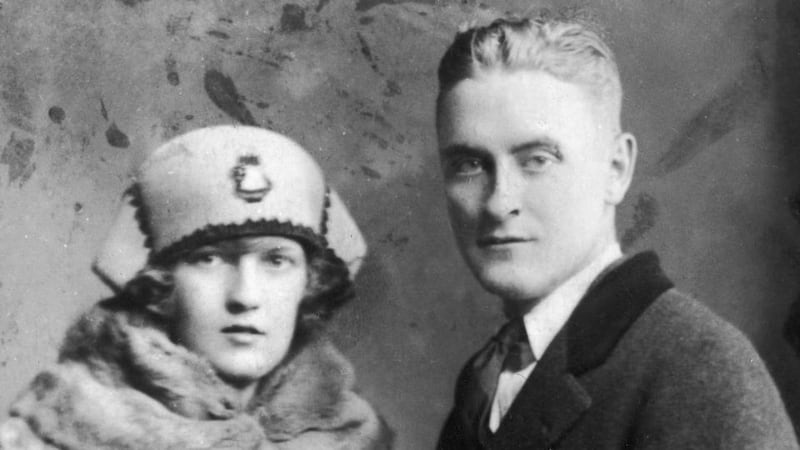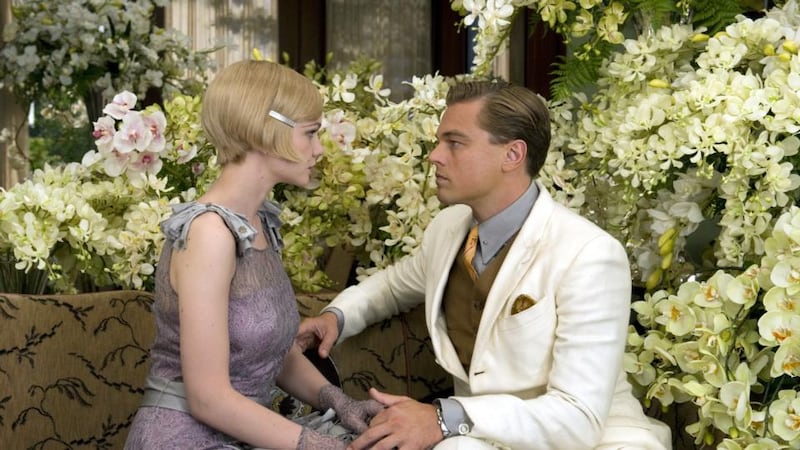If you stand outside 200 Claremont Avenue, a residential strip of upper Manhattan that runs past the rear entrance of Barnard College to the fringes of Harlem and is distinguished only as the windiest thoroughfare in New York, you will find no brass marker declaring that F Scott FitzGerald once lived there. The same is true of 40 West 59th Street, where, in October 1920, FitzGerald and his new bride, Zelda, took a room not long after their antics prompted a request for them to check out of the Biltmore Hotel. Their new dwelling had the advantage of being so close to the Plaza that the couple could have their meals delivered. “We quarrelled and you broke the bathroom door and hit my eye,” Zelda wrote to her husband years later, when reminiscing of their typically stormy time at that address. “We went to so much theatre that you took it off the income tax.”
The Biltmore itself, an outrageously opulent structure on Madison Avenue, was hastily torn down in August 1981, when it had become financially untenable in a smashed-broke city. And the Land's End mansion at Great Neck, on Long Island, considered the inspiration for Daisy Buchanan's fictional home in FitzGerald's novel The Great Gatsby , was demolished in 2011 simply because its owners could not afford to maintain it, so it joined an estimated 500 vanished mansions of the Roaring Twenties. Beacon Towers, the monstrous coastal palace on which Jay Gatsby's mansion was partly based, didn't make it past 1945.
So if FitzGerald could walk through his city now, he would find much of it unfamiliar. But his voice remains strong in its shifting mythology. On Fifth Avenue, down which Fitzgerald boasted of rolling empty champagne bottles on Sunday mornings, Tiffany & Co displays a homage to the Gatsby era, with elegant bepearled mannequin arms linked in perpetual toast over a cascade of champagne glasses dripping in diamonds. Across the road, the Prada store’s Gatsby display features diaphanous jazz-age dresses and smart suits. Billboards of Leonardo DiCaprio’s tuxed and tawny Gatsby are everywhere, advertising yesterday’s US opening of Baz Luhrmann’s film adaptation.


"Getting ready for the movie?" asks the young librarian at Grand Central Library as he searches for Some Sort of Epic Grandeur , Matthew Bruccoli's biography of FitzGerald. "It should be . . . interesting."
Dozens of jazz-age-themed weddings are taking place across New York this year, and teasers of the film’s soundtrack, scored by Jay Z, have been issued in advance of the opening. The venerable Strand book store, not far from Union Square, sells a range of Gatsby T-shirts. Anyone who has spent any time in the Strand has probably encountered Ben McFall, who, since 1978, has been dispensing solicited advice on fiction with generosity and charm and who happily admits to being fascinated by the FitzGeralds.
“They are a captivating couple. Scott embodied that so-called jazz-age period before the war when normal or middle-class people sort of went crazy and had fun for the first time,” says McFall.
"There was a lot of identification with that in the 1960s too. I feel as a literary work that Gatsby has always been thought of highly. Gertrude Stein liked it when it was published. It has done continually well over the years. I was selling books when the previous Gatsby movie, with Robert Redford, was coming out. And it was more exciting then, because there was a real nostalgia going on about the 1920s."
Revival is evident now, too. On the subways, people hunch over the slender book that has, since 1925, come to represent the haunting and frivolous moneyed period before the harrowing Great Depression and the slow slide into the second World War.
"This ironic tale of life on Long Island at a time when gin was the national drink and sex the national obsession," was how the book was summed up in FitzGerald's obituary in the New York Times .
The novel, for all its shallow people and jaded partying, taps effortlessly into the recurring preoccupations of the young: with aesthetics, with pleasure-seeking, with fun and sin and wealth and, above all, with evading boredom.
It also contains many of the most memorable descriptions of New York. “The city seen from the Queensboro bridge is always the city seen for the first time, in its first wild promise of all the mystery and beauty in the world.”
That very promise, along with the more practical opportunity of finding work, is surely the essence of what has brought generations of people to New York.
Colum McCann, the Irish author of Let the Great World Spin , itself an indelible work of fiction about New York, has spent half of his life in the city. "I think about the book every time I take the train out to Long Island where my wife's family lives," he says. "From the Long Island railroad you can still look out over the tracks and see the world of ash-grey men in shirtsleeves."
Literary king
The journey preceding FitzGerald's brief, antic reign as the literary king of 1920s Manhattan began when Philip McQuillan left Co Fermanagh in 1857 and found his way to St Paul, Minnesota. There he married Louisa Allen, the daughter of an Irish immigrant carpenter; they named their eldest daughter Mary. Little is known of the writer's paternal grandfather, Michael FitzGerald, except that he stayed around Maryland long enough to marry Cecilia Ashton Scott and had a son, Edward, who married Mary McQuillan.
So, just over 60 years after McQuillan departed Ulster, his grandson had written one of the defining New York and American novels, viewed from the perspective of an outsider: a midwesterner who goes east with his eyes wide open.
“FitzGerald came from Minnesota to New York when it was very exciting. He took in the theatre and the jazz movement, and he was just carried away by it all,” says Dr Ruth Prigozy, of Hofstra University, who is one of the foremost Fitzgerald scholars.
"He wrote very late in life, in My Lost City , associating New York as a very positive time in his life and the 1920s as a boom time for the US. He moved around a bit, and in my view, unfortunately, he met Zelda when he was down in Alabama, and she was a very disturbed woman. He was wonderful to her, but it was a difficult, difficult marriage.
“I have lived in New York all my life, and it has changed so much that I don’t look at it with that vision FitzGerald had . . . But non-New Yorkers see all their dreams and possibilities in that book.”
And it is to those naive, optimistic millions who have prospered or failed in the city down the years that FitzGerald calls out. In My Lost City he recalls the crushing loneliness of his early months in New York as a struggling advertising writer with Barron Collier, when a glamorous afternoon would always lead back to the reality: "my shabby suits, my poverty and love" and the walk up Claremont, where he kept his rejection slips posted on the wall in his room.
One of the most famous descriptions of New York in Gatsby is of an "enchanted metropolitan twilight", but it belongs to a sentence aching with empathy for the lives of many people living on such a small parcel of land.
“At the enchanted metropolitan twilight I felt a haunting loneliness sometimes and felt it in others – poor young clerks who loitered in front of windows waiting until it was time for a solitary restaurant dinner – young clerks in the desk, wasting the most poignant moments of night and life.”
Glamour and melodrama
FitzGerald did not toil long in their number: after the runaway success of This Side o f Paradise , in 1920 , he began to live with abandon and found his match in Zelda: both had a gothic sensibility and an insatiable attraction to glamour and melodrama. He earned $28,754 in 1923; his attempts at monthly budgeting, as detailed in Bruccoli's biography, are comical. Subways $29. Wild Parties $100. They spent as recklessly as Gatsby but without his limitless income, and by the 1930s FitzGerald's visits to New York were brief, alcohol-fuelled raids from Hollywood; he was hospitalised twice in the last years of his life. But as the decades rolled on, his interpretation of 1920s New York seemed more magnetic than ever. It became clear that it was both an extravagant period piece and utterly timeless.
Ben McFall grew up in Detroit and was 19 when he came to New York, in the middle of the disco age. The costumes and sounds differed, but in its excess of spirit and hedonism it was straight from the pages of Gatsby .
“The city will always hold that kind of allure for people,” McFall says. “It comes and goes, according to what is going on. When I first came to New York I was afraid to move into the city, because it was just too much for me. And I was desperately trying to catch up with my peers. But I am glad I didn’t now, because I would be dead. The city couldn’t have been more wide open. It was unbelievable.”
New York has gone through several metamorphoses since, from the graffiti and squalour of the 1980s to the dotcom rush of the late 1990s and the trauma of 9/11, without ever losing the atmosphere that is somehow captured on the pages of Gatsby .
"The brilliance of any book is its ability to be timeless," says Colum McCann. "But no book is quite as timeless as Gatsby . It is so cinematic in terms of prose that I still carry it in my mind, years and years after reading it. All those pink rags of suits, the moles shaped into cufflinks. I think just as Dublin is increasingly shaped by our idea of Ulysses , so it is with New York and Gatsby . Leopold Bloom and Nick Carraway have a lot in common, I suppose."
The problem for all film-makers remains the same. “How do you replicate that language?” asks Ruth Prigozy. “There is so much buried beneath those sentences. And people misconstrue the book as being about success. If there is a message, it is that we have to keep going because there is nothing else to do. It’s a very sad book.”
And, to the last, it remains an outsiders' view of New York, with Nick Carraway casting his bewitching and appalled judgment on all he surveys. FitzGerald fled New York several times, writing most of The Great Gatsby in France. It has become a standard on the American school curriculum, and the film, already regarded as the big movie event of the year, has brought him firmly back into fashion.
You have to fancy that FitzGerald would approve of the parties, at any rate, and that he would stress that none of this fuss can last. Even in the brightest times, he had an inkling of that. In Life in Letters he remembered a moment when he was young and the toast of the roaring city, copies of his debut book selling as fast as Scribner's could print them.
“I remember riding in a taxi one afternoon between very tall buildings under a mauve and rosy sky; I began to bawl because I had everything I wanted and knew I would never be so happy again.”
The Great Gatsby opens on Thursday











